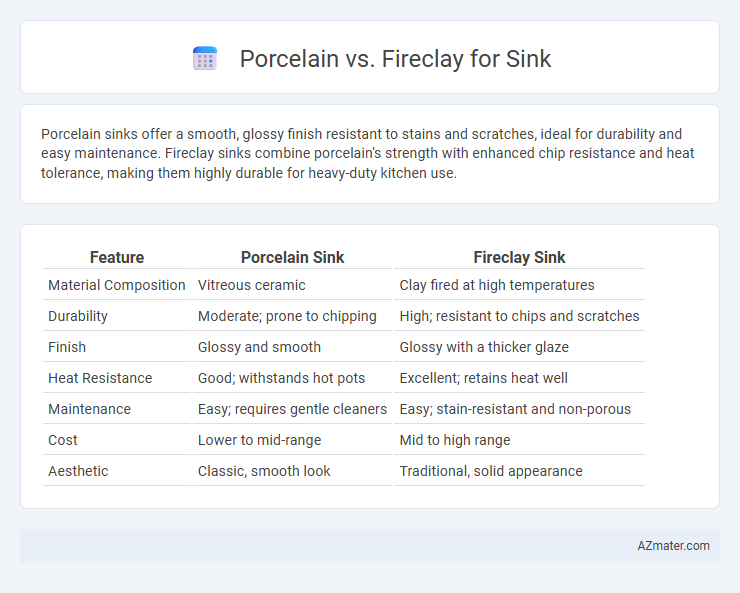Porcelain sinks offer a smooth, glossy finish resistant to stains and scratches, ideal for durability and easy maintenance. Fireclay sinks combine porcelain's strength with enhanced chip resistance and heat tolerance, making them highly durable for heavy-duty kitchen use.
Table of Comparison
| Feature | Porcelain Sink | Fireclay Sink |
|---|---|---|
| Material Composition | Vitreous ceramic | Clay fired at high temperatures |
| Durability | Moderate; prone to chipping | High; resistant to chips and scratches |
| Finish | Glossy and smooth | Glossy with a thicker glaze |
| Heat Resistance | Good; withstands hot pots | Excellent; retains heat well |
| Maintenance | Easy; requires gentle cleaners | Easy; stain-resistant and non-porous |
| Cost | Lower to mid-range | Mid to high range |
| Aesthetic | Classic, smooth look | Traditional, solid appearance |
Introduction to Porcelain and Fireclay Sinks
Porcelain sinks, made from fine clay fired at high temperatures, offer a smooth, glossy finish that resists stains and scratches, making them durable and easy to clean. Fireclay sinks are crafted from ceramic clay fired at even higher heat, resulting in a robust, chip-resistant surface with a distinctive matte or glossy finish that enhances kitchen aesthetics. Both materials provide exceptional durability and classic appeal, but fireclay often delivers superior strength and resistance to thermal shock compared to traditional porcelain.
Material Composition and Manufacturing Process
Porcelain sinks are crafted from vitrified clay mixed with feldspar, kaolin, and quartz, then fired at high temperatures to achieve a glossy, durable finish that resists scratches and stains. Fireclay sinks are made from refined, highly purified clay fired at temperatures above 1,200degC, resulting in a dense, non-porous surface with exceptional hardness and thermal resistance. The manufacturing process for fireclay involves longer firing times and higher temperatures than porcelain, producing a more robust and impact-resistant sink ideal for heavy-duty use.
Aesthetic Differences: Looks and Finish
Porcelain sinks feature a smooth, glossy finish that offers a classic, shiny appearance with a bright white or off-white color, enhancing traditional or modern kitchen designs. Fireclay sinks have a thicker, more substantial feel with a matte to satin finish that provides a warm, rustic, and handcrafted look, often available in earth tones and soft whites. The visual contrast between porcelain's sleek, reflective surface and fireclay's textured, muted finish caters to different aesthetic preferences and interior styles.
Durability and Resistance to Damage
Fireclay sinks exhibit superior durability compared to porcelain due to their dense composition, which makes them highly resistant to scratches, chips, and thermal shock. Porcelain sinks, while aesthetically pleasing, tend to be more prone to surface cracks, stains, and damage from heavy impacts. Both materials offer water and heat resistance, but fireclay's robust fired clay-and-silica blend ensures longer-lasting structural integrity under regular kitchen use.
Stain and Scratch Resistance Comparison
Porcelain sinks offer a smooth, non-porous surface that resists stains but can be prone to chipping and scratching under heavy use. Fireclay sinks, made from ceramic clay fired at high temperatures, provide exceptional durability with superior scratch resistance and enhanced stain resistance due to their dense, vitreous surface. Both materials maintain color integrity over time, but fireclay generally withstands harsh cleaning agents and abrasive impacts better than porcelain options.
Maintenance and Cleaning Requirements
Porcelain sinks require gentle cleaning with non-abrasive cleaners to prevent surface chipping and discoloration, making daily maintenance straightforward but careful. Fireclay sinks offer superior resistance to stains and scratches due to their vitrified ceramic composition, allowing for more robust cleaning routines without damage. Both materials benefit from regular wiping to avoid mineral build-up, but fireclay's dense, glass-like surface generally demands less frequent deep cleaning compared to porcelain.
Cost Considerations: Porcelain vs Fireclay
Porcelain sinks typically cost less than fireclay sinks, making them a budget-friendly option for homeowners. Fireclay sinks, known for their durability and resistance to chips and stains, often come with a higher price tag due to their labor-intensive manufacturing process. When considering cost, it's important to weigh initial investment against long-term durability and maintenance expenses, as fireclay may offer greater longevity despite its higher upfront cost.
Installation Differences and Sink Shapes
Porcelain sinks are typically lighter and easier to handle during installation, fitting well into drop-in or undermount configurations, while fireclay sinks tend to be heavier and require more precise support structures, often favoring farmhouse or apron-front styles. Fireclay's rigidity and durability make it better suited for custom or integrated countertop installations that demand exact measurements and professional fitting. Porcelain offers more flexibility in shapes and mounting options, whereas fireclay's robust construction limits it primarily to rectangular or square shapes with apron-front designs.
Suitability for Kitchen and Bathroom Use
Porcelain sinks offer a smooth, non-porous surface making them highly resistant to stains and easy to clean, ideal for both kitchen and bathroom environments. Fireclay sinks provide exceptional durability and chip resistance due to their vitreous enamel coating, making them well-suited for heavy kitchen use and frequent water exposure in bathrooms. Both materials withstand high temperatures, but fireclay's thicker construction generally offers greater impact resistance, enhancing long-term functionality in busy households.
Pros and Cons of Porcelain and Fireclay Sinks
Porcelain sinks offer a smooth, glossy finish that resists stains and is easy to clean, but they can chip or crack under heavy impact. Fireclay sinks are more durable and heat-resistant due to their ceramic and clay composition, providing excellent longevity and maintaining color vibrancy over time. However, fireclay sinks tend to be heavier and more expensive, requiring sturdy cabinetry and professional installation.

Infographic: Porcelain vs Fireclay for Sink
 azmater.com
azmater.com